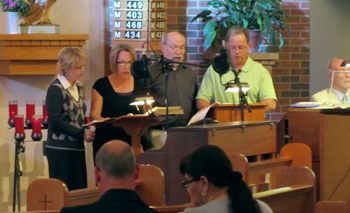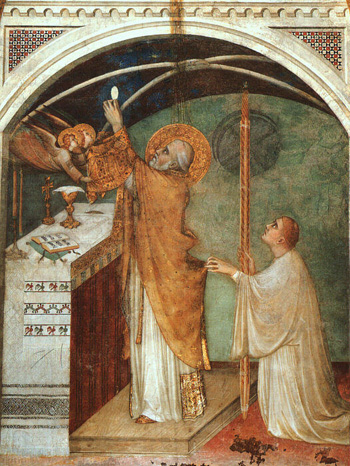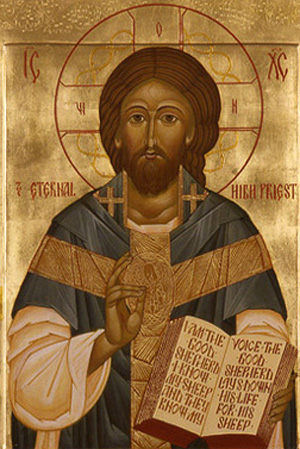The Liturgy Is Not a Work of the People
Dr. Carol Byrne
The leaders of the Liturgical Movement were aware of the power of the traditional lex orandi – the fixed rites, hieratic language and gestures, ceremonial vestments, architecture and sacred music – to focus the mind on the transcendent nature of the liturgy. It was abundantly clear to all the faithful, priests and people alike, that what was taking place at the altar was a divine action.
For Jungmann and some of his associates, however, it was
this very transcendence that was a “scandal” because it failed to give
the people an active role in the liturgy. He complained in the following
terms:
“The Mass is viewed almost exclusively as an action of God. In the
liturgical unfolding of the celebration of Mass, the action of the
Church, its prayer of thanks and its gift-offerings are no longer
perceived as in former ages; only the work, the redeeming work of God.
The priest alone is active. The faithful, viewing what he is performing
are like spectators looking on at a mystery-filled drama of Our Lord’s
way of the Cross.” (1)
It is quite obvious from this and many other statements made by Fr.
Jungmann that he wanted his readers to believe that the traditional
sense of worship of God was unacceptable. His statement carries the
implication that the lex orandi as it was practiced for
centuries was not the authentic liturgical tradition of the Catholic
Church, because it was too God-centered and priest-dominated.
The question needs to be asked: Could this have been written by a priest
who was truly holy? Had this statement come from the pen of a less able
and distinguished person, it might have passed unnoticed or have been
dismissed as the prejudice of an anti-Catholic bigot heaping scorn on
the Church’s sacred Tradition. (But he built his career on doing just
that.)
Unfortunately, with his ascribed status of a liturgical giant, Jungmann
was listened to in the highest echelons of the Church and gained the
undying admiration of the reformers.
It is, therefore, important that Catholics, especially priests, should
examine the accuracy and the implications of what he was alleging
against the Church. We shall begin our investigation by asking and
answering the following questions based on Jungmann’s theories.
- In what sense precisely is the liturgy not “exclusively an action of God”?
- Why should the fact that “the priest alone is active” lead to the
conclusion that the traditional manner of celebrating Mass is a
“corruption” of the lex orandi?
- How does the unique role of the priest actually prevent the faithful from true, spiritual participation in the liturgy?
Is liturgy the “work of the people”?
These questions can be answered at a stroke by refuting the basic
premise of the Liturgical Movement that “liturgy” means fundamentally
the “work of the people” in the sense of a celebrating community.
The idea was first proposed in 1909 by Dom Beauduin
as representing the “true prayer of the Church” (2) in opposition to
the traditional teaching that it pertains to the priest alone to
celebrate the Mass. It found a ready acceptance among the avant garde
in the Liturgical Movement, who wanted to revolutionize the Church’s
liturgy in the direction of “active participation” for all the laity,
“not just for the priest,” as Beauduin put it.

Members of the ‘music ministry’ performing in the front of the Church
But it was largely due to the influence of Jungmann’s
writings that the idea of the laity as the active principle in the
liturgy took root in the Church and bore the blighted fruit of so-called
lay “ministries” in the novus ordo.
Some of the more daring and imaginative reformers claimed to have
“proved” the work-of-the-people thesis by resorting to etymology, only
to fall flat on their faces. The word Liturgy, they assert (correctly),
is derived from the Greek leitourgia; but they mistakenly claim that this word is composed of two elements: laos (people) and ergon (work). It sounds plausible, but the problem is that it is not true.
Leitourgia is actually derived from leitos, meaning “public” and was originally used to denote acts of public service undertaken by a benefactor (leitourgos)
for the good of the community. (3) It was undoubtedly “work” and it
was certainly about “people,” but it was never meant in the sense of
“work of the people.”
In other words, the work was not done by the people, but for them
and on their behalf. (4) How unethical it would be if the people
failed to recognize their benefactor’s munificence and attributed the
glory of his deeds to themselves!
The liturgy is in its essence the action of Christ
There is an obvious correlation between this ancient usage and the
traditional liturgy insofar as it shows the distinction between the leitourgos and the people. For Christ is identified by St. Paul as our Leitourgos (Minister of the sanctuary) (5) and continually gives His life for the spiritual benefit of the people. It is essentially His (not our) redeeming work for the salvation of souls; it is His Sacrifice for His people, His
earthly ministry that the priest alone performs in His name. Therefore,
the liturgy is not something that we do, but that Christ does for our
salvation.

Jungmann's notion of the Mass was opposed to the priest renewing the Sacrifice of Christ on the altar
but Jungmann took a diametrically opposite view:
“In reality, from its very beginning the structure of the Mass portrays it as our sacrifice;
it is our entering into the sacrifice of Christ; it is our affiliation
with His oblation to the heavenly Father.” [emphasis in the original]
(6)
So, the term “Holy Sacrifice of the Mass” is no longer heard, because
today worship is viewed as the “work of the people,” an overwhelmingly human
action. There was a conscious sidelining within the Liturgical Movement
of the teaching of the Council of Trent that the Mass is the Sacrifice
of Calvary renewed on the altar. Jungmann stated that “thinking of the
Mass almost exclusively as a sacrifice is a one-sided attitude resulting
from the doctrinal controversies of the 16th century.” (7)
In fact, until the Liturgical Movement altered its meaning, the word “leitourgia,”
when applied to the Church’s worship, was understood to designate the
activity of Christ the High Priest; secondly and by extension, the
activity of the priest who officiates in loco Christi (in the
place of Christ). This understanding of the Mass is not only rooted in
Scripture, but is visibly enshrined in the traditional rites where “the
priest alone is active”.
In other words, it has been traditionally understood that liturgy is, by its very nature, a clerical activity.
Repudiation of the past

Christ as High Priest - gone in the novus ordo anti-liturgy
This is the very concept that the Liturgical Movement was set up to stifle. It succeeded so well that the Catechism of the Catholic Church (1992) now teaches that: “In a liturgical celebration, the whole assembly is leitourgos,” (8) i.e., collective ministers of the Church’s official worship by reason of their common priesthood.
So, on this view, the title of Christ as Leitourgos and the role of the priest acting as alter Christus are no longer unique, but shared democratically among the lay people.
The novus ordo: an anti-liturgy
It follows that, insofar as the novus ordo is the “work of the
people,” it loses its divine character and cannot lay claim to the title
of liturgy in the sense of true worship of God. It is not just a
non-liturgy, but an anti-liturgy. It has been devised in such a way that
in practice the people act as if they were the main focus of worship,
rather than God. They celebrate their own lives and achievements in this
world only. This is particularly evident in the Requiem Mass.
Those who participate in such ceremonies are often misled into believing
that God is nothing more than the community, which comes together in
church. This explains how it has become second nature for the novus ordo
priest to turn his back on Christ in the tabernacle and face the
people, whom he now instinctively considers as the real protagonists in
the liturgy.
To be continued
- Josef Jungmann, The Mass of the Roman Rite, vol. 1, p. 117
- This was the title of the address he gave at the Malines Conference in 1909 which inaugurated the Liturgical Movement.
- In ancient Greece, leitourgia referred to an act of public service performed by a private citizen (the leitourgos)
at his own expense. Thus, for example, a wealthy Athenian might
construct a civic building such as a theatre or temple, build a bridge,
fit out a war ship and pay the crew, or finance sporting and cultural
events.
- The Liturgical Movement’s influence on this point was so great that
modern liturgists still echo Jungmann’s complaint that the faithful were
excluded from the pre-Vatican II liturgy. For example, the Benedictine
Kevin Seasoltz expressed his outrage that “for almost 400 years before Sacrosanctum Concilium, the rubrics of the 1570 Missal of Pius V provided that the Mass was celebrated for the people rather than by the people.” (Kevin Seasoltz, O.S.B., ‘The Liturgical Assembly: Light From Some Recent Scholarship,” in Rule of Prayer, Rule of Faith: Essays In Honor Of Aidan Kavanagh O.S.B. (Collegeville, MN: The Liturgical Press, 1996), p. 322).
- St Paul, Letter to the Hebrews 8:2.
- Ibid., p. 115.
- J. A. Jungmann, Announcing the Word of God, trans. from the German by Ronald Walls (London: Burns and Oates, 1967), p. 111.
- Catechism of the Catholic Church, 1992, § 1188.

Members of the ‘music ministry’ performing in the front of the Church

Jungmann's notion of the Mass was opposed to the priest renewing the Sacrifice of Christ on the altar

Christ as High Priest - gone in the novus ordo anti-liturgy
- Josef Jungmann, The Mass of the Roman Rite, vol. 1, p. 117
- This was the title of the address he gave at the Malines Conference in 1909 which inaugurated the Liturgical Movement.
- In ancient Greece, leitourgia referred to an act of public service performed by a private citizen (the leitourgos) at his own expense. Thus, for example, a wealthy Athenian might construct a civic building such as a theatre or temple, build a bridge, fit out a war ship and pay the crew, or finance sporting and cultural events.
- The Liturgical Movement’s influence on this point was so great that modern liturgists still echo Jungmann’s complaint that the faithful were excluded from the pre-Vatican II liturgy. For example, the Benedictine Kevin Seasoltz expressed his outrage that “for almost 400 years before Sacrosanctum Concilium, the rubrics of the 1570 Missal of Pius V provided that the Mass was celebrated for the people rather than by the people.” (Kevin Seasoltz, O.S.B., ‘The Liturgical Assembly: Light From Some Recent Scholarship,” in Rule of Prayer, Rule of Faith: Essays In Honor Of Aidan Kavanagh O.S.B. (Collegeville, MN: The Liturgical Press, 1996), p. 322).
- St Paul, Letter to the Hebrews 8:2.
- Ibid., p. 115.
- J. A. Jungmann, Announcing the Word of God, trans. from the German by Ronald Walls (London: Burns and Oates, 1967), p. 111.
- Catechism of the Catholic Church, 1992, § 1188.
